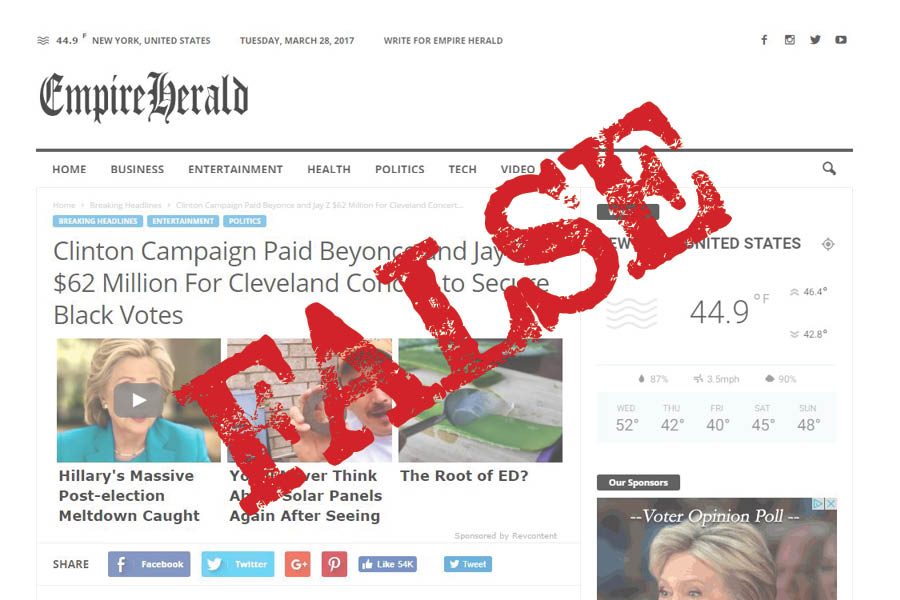Fact or fiction?
The public falls victim to the spread of fiction parading as fact
This story is just one of many published as news throughout the 2016 presidential election that is completely fabricated.
“Wee the people:” a story about Secretary Hillary Clinton’s campaign bus illegally dumping human waste in the streets of Lawrenceville, Georgia.
“Stay off the ice kids! Drowned fox frozen in a block of ice:” a story about a fox found frozen in the Danube River in Fridingen, southern Germany.
One of the headlines accompanies an actual news story written by professional journalists who hold themselves to accepted ethical practices of seeking the truth and reporting it while the other…
The other story is just that–a story. These stories are fabrications and flashiness created to satisfy readers who want to confirm their already-held beliefs. These unfounded and often uninvestigated claims generate a following (and revenue) for the creators and their advertisers.
The story about the frozen fox is factual, while the Clinton campaign bus article is bogus.
People are generating misinformation and dressing it up as fact on social media and online sites. This practice is dangerous, spreading falsehood into the public who fall victim to these reports.
Hopefully, students recognize NBC News as a reputable news organization. While World Net Daily is a conservative conspiracy site, according to the Southern Poverty Law Center, a non-profit organization that uses litigation, education and other forms of advocacy to ensure justice for vulnerable members of society.
WND is an example of a site that provides enticing headlines just waiting for a click from the reader to open.
The 18 students of Journalism Writing and Reporting interviewed 36 students and 24 adults exploring the reach and effects of fabricated “news” stories that are plaguing social media users.
“I don’t know what’s happening,” Aaron Christianson (9) said.
He’s not alone. Teenagers and adults alike are often unaware that they are consuming these stories that are pure fiction posing as fact. People are also unaware of the threat these stories pose..
Social media sites, like facebook, have proven to be the main proprietor of fake news. This generation of teenagers relies largely on social media outlets as their only source of news.
“Two-thirds of facebook users get news on the site,” according to a survey conducted in the winter of 2016 by The Pew Research Center. facebook boasts “1.18 billion daily active users on average for September 2016” That means more than 678,666,667 readers use facebook as their news source, which is the most popular vehicle for these stories of fiction parading as news.
Despite the fact that facebook sees a very wide demographic of users, it appears that high school students and teenagers fall victim to being misinformed the most.
The Stanford History Education Group conducted a study in the winter of 2016 where they showed 7,800 students a photo of deformed flowers accompanied by a caption that the flowers have “nuclear birth defects.” The students then constructed responses regarding the photo’s validity. The results show the students’ major lack of education discerning fake news from actual news.
“They ignored key details, such as the source of the photo. Less than 20% of students constructed ‘Mastery’ responses or responses that questioned the source of the post or the source of the photo,” the SHEG study reported.
The false stories are published to grab people’s attention and make them feel a particular way.
Last December, journalist Craig Silverman spoke on NPR’s “Fresh Air”about his team’s analysis of stories posted on social media. They observed the spread of fake news during the 2016 presidential election campaign. With the data they observed at nine and six months before the election, there was not a significant amount of falsehood spread, but when they observed at three months before the election, there was a major spike in the amount of fake news shared. Silverman’s study shows that many of these unreliable sources will release falsehood into the public in order to grab their attention and sway readers a certain way. With the election at a critical time, just three months away, a spike of falsehood around that time was definitely no coincidence.
“You’re taking people’s emotions and you’re taking people’s fears and you’re taking people’s hopes and ambitions and you’re catering to that,” Nick Weaver, EHS-hub Broadcast News editor-in-chief, said.
Social media is an easy way to receive daily news, but it’s also an easy way to spread falsehoods and rumors.
“It’s become a problem mainly just because of social media and because a lot of people, instead of following traditional media outlets, have started following the social media outlets where it is much easier to spread false facts,” Noah Cross (11) said.
People of all ages, especially teenagers, fall for these falsehoods.
“People want to believe these stories because they are more entertaining,” Grant Eickel (12) said.
Although the information is made-up, organizations publish the information in a way to makes the readers believe it is true with mastheads and formatting that mimics news sites.
“Anybody can create anything and make it look reputable,” Andrew Gensler, Language Arts, said. “A lot of it comes down to the person who is consuming the information.”
However, there are ways to tell if a story is dependable or misleading.
“Rationality, I know normal headlines are trying to grab my attention, but when something is drastically ridiculous I can tell,” Ryan Zieg, SSD, said. “I’ll look at the link sometimes, and it will say, ‘ad,’ inside the link or if it’s not from a reputable source and I’m curious about the information, then I’ll do a Google search to see if that’s accurate outside of just the one article that has it.”
Referencing multiple reputable news organizations is another strategy.
“You kind of hear a little bit of differences,” Kim Laubacker, parent, said. “I’m constantly changing news stations to see what everyone’s reporting on on certain subjects because no one’s ever exactly right.”
Data shows that older consumers primarily get their news from TV with news anchors with recognizable faces and names, making them less susceptible to hoaxes, but–perhaps–more susceptible to the personal beliefs of pundits.
The 24-hour news networks–however–have muddied the waters. The channels fill their airwaves with pundits who serve as their own talk show hosts rather than journalists reporting the news. Since these pundits exist on news channels, they can easily be mistaken as journalists. But they aren’t.
Adults watching the 24-hour news channels need to make sure they aren’t confusing pundits whose words should be taken as entertainment for anchors who are reporting the news.
Younger audiences who get their news online need to be cautious of posts that parade as news but are really entertainment. Buzzfeed, commentators, blogs, biased organizations and various posts on Twitter, facebook and Wikipedia should be treated as sources of amusement and entertainment.
When trying to discover the truth and reliability of a source, there are many dead giveaways as to whether or not a story is reliable. By using the following tips, any reader will know what it takes to decipher a fake news story from a credible source.
Within these stories, there are key details that show the signs of misinformation. Unless the public takes it upon themselves to education themselves in this the age of digital information falsehoods and fiction will pass through society as fact. Clearly this ability is not successfully being taught in schools at this time.
Your donation will support the student journalists of Eureka High School - MO. Your contribution will allow us to purchase equipment and cover our annual website hosting costs.




















